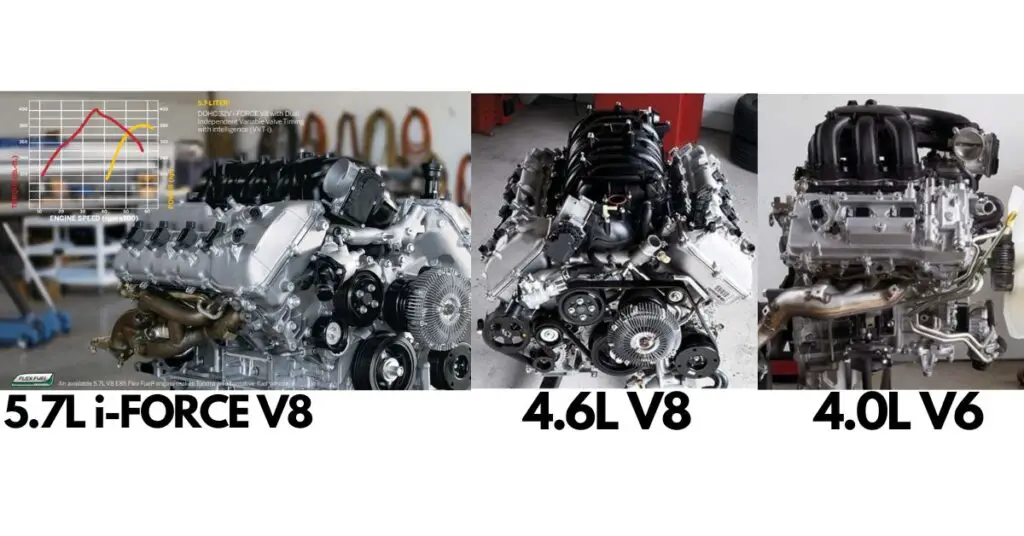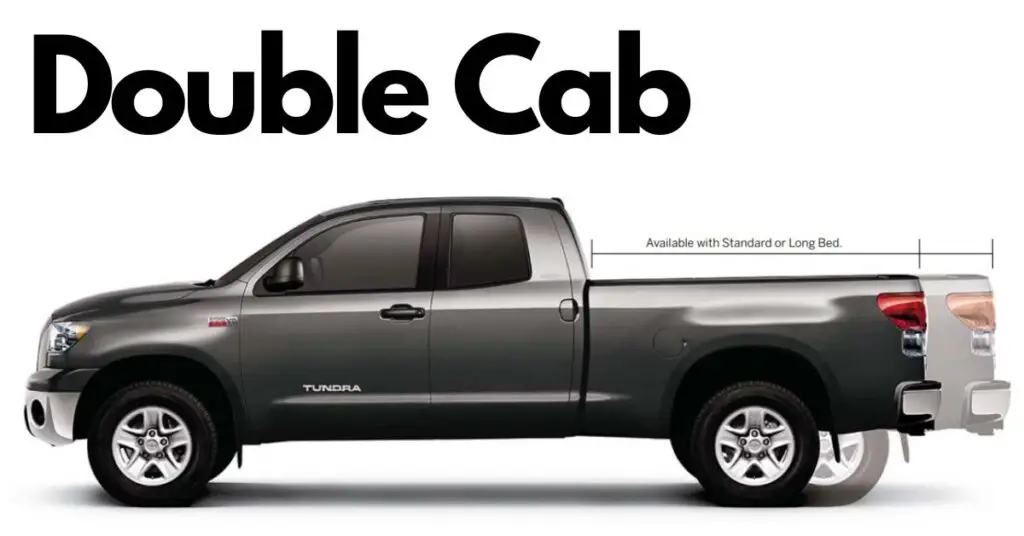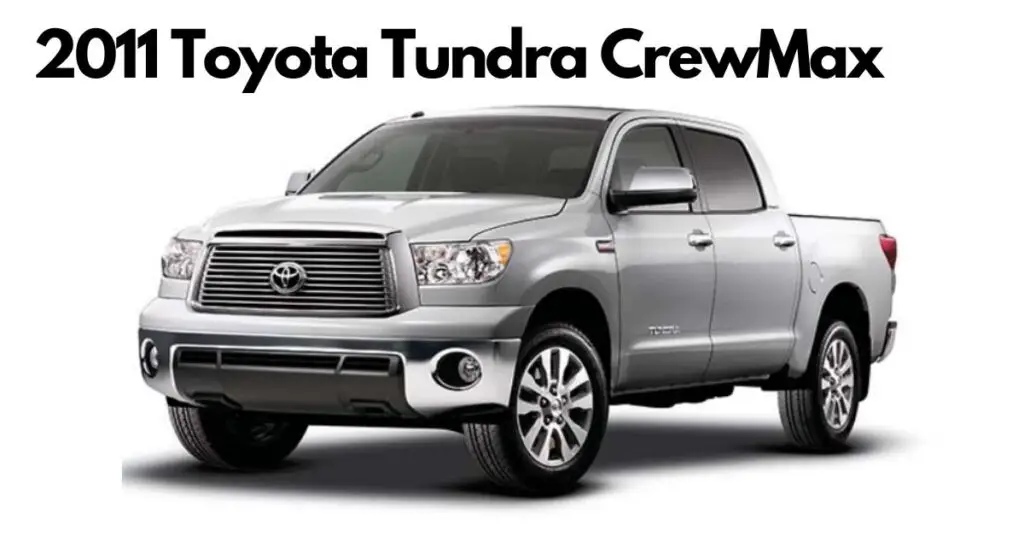2011 Toyota Tundra towing capacity chart
Toyota truck core engineering is known for built-to-last strength, toughness, and reliability. The 2011 full-size Tundra is truly remarkable with its proven capabilities, building a stronger, tougher, and smarter pickup. So when there’s work to be done, Tundra owners know they can load it up, hitch it on and get moving with sufficient towing capabilities. In, this article you will discover all the trim levels with options for the 2011 Toyota Tundra with respective tow ratings.
| 2011 Toyota Tundra trim levels | 2011 Toyota Tundra towing capacity |
| Toyota Tundra Regular Cab | 4,800 – 10,400 |
| Toyota Tundra Double Cab | 4,500 – 10,100 |
| Toyota Tundra CrewMax | 7,700 – 9,900 |
| Toyota Tundra Limited | 9,000 – 10,000 |

2011 Toyota Tundra Engine options
Toyota Tundra offers a choice of engines, including 5.7L i-FORCE V8 and 4.6L engines, and the 4.0L V6 knows what you want from a truck motor: torque response is on tap across a wide range of rpm. An Acoustic Control Induction System optimizes the engine’s response whether you’re accelerating from a stoplight with a trailer in tow or just in need of some extra punch at higher rpm. To optimize the engine’s volumetric efficiency, VVT-i knows exactly how long to leave the valves open so that the engine pumps as much air as possible is the reason the power band is so wide. It easily performs any task whether that means hauling, towing, or simply heading home.
5.7L i-FORCE V8: Dual Independent VVT-i can even adjust the timing for the intake and the exhaust valves independently, with remarkable results: More than 90% of the 5.7L V8’s peak torque of 401 lb.-ft. is on tap from just 2,400 rpm all the way to 5,500 rpm. The available 5.7L i-FORCE V8 features an exhaust system with a pair of 4 into 2 into 1 tubular headers. This design helps the exhaust fl ow more freely, reducing back pressure and enhancing mid-range torque. Made from stainless steel, the design is also lighter and more corrosion-resistant than cast-iron manifolds. 4.6L V8: The compact 4.6L V8 gives you some serious power per liter. After all, it pays to be as efficient as possible. 4.6L DOHC 32-Valve i-FORCE V8 with Dual Independent Variable Valve Timing with intelligence (VVT-i), Horsepower: 310 hp @ 5,600 rpm, Torque: 327 lb.-ft. @ 3,400 rpm, aluminum block with aluminum heads, dual-stage intake manifold, Compression ratio: 10.2:1, Emissions: ULEV-II. 4.0L V6: All-aluminum 4.0L V6 engine its 24 valves are actuated by Double Overhead Cams (DOHC) and controlled by Dual Independent Variable Valve Timing with intelligence (VVT-i). The result is a technologically advanced engine with an old-fashioned work ethic: Its peak power output is 270 hp at 5,600 rpm and 278 lb.-ft. of torque at just 4,400 rpm.

2011 Toyota Tundra Regular Cab 4×2 towing capacity
With available in Standard Bed (6.5 ft.) or Long Bed (8.1 ft.) configurations. Available in three engine sizes: 4.0L V6, 4.6L V8, and 5.7L V8. 4×2 5.7L V8 Long Bed features a maximum payload capacity of up to 2,090 lbs. when properly equipped. 4×2 4.6L V8 Standard Bed rated for 1,870-lbs. maximum payload. 4×2 5.7L V8 Long Bed features a standard towing capacity of 10,400 lbs. V6 Standard Bed offers a maximum towing capacity of 4,900 lbs.
| Specs | 4×2 Regular Cab 4.0L V6 (Standard Bed) | 4×2 Regular Cab 4.0L V6 (Long Bed) | 4×2 Regular Cab 4.6L V8 (Standard Bed) | 4×2 Regular Cab 5.7L V8 (Long Bed) |
| Curb Weight(lbs.) | 4,580 | 4,685 | 4,730 | 4,910 |
| GVWR (lbs.) | 6,200 | 6,400 | 6,600 | 7,000 |
| Payload (lbs.) | 1,620 | 1,715 | 1,870 | 2,090 |
| Towing (lbs.) | 4,900 | 4,800 | 8,600 | 10,400 |

2011 Toyota Tundra 4×4 Regular Cab towing capacity
| Specs | 4×4 Regular Cab 5.7L V8 (Standard Bed) | 4×4 Regular Cab 5.7L V8 (Long Bed) |
| Curb Weight(lbs.) | 5,080 | 5,180 |
| GVWR (lbs.) | 6,800 | 7,200 |
| Payload (lbs.) | 1,720 | 2,020 |
| Towing (lbs.) | 9,200 | 10,100 |

2011 Toyota Tundra 4×2 Double Cab towing capacity
With available in Standard Bed (6.5 ft.) or Long Bed (8.1 ft.) configurations. Available in three engine sizes: 4.0L V6, 4.6L V8, and 5.7L V8. 4×2 5.7L V8 Standard Bed features a maximum payload capacity of up to 1745 lbs. 4×2 4.6L V8 Standard Bed rated for 1615-lb. maximum payload. 4×2 5.7L V8 Standard Bed features a towing capacity of 10,100 lb. when properly equipped. V6 Standard Bed offers a maximum towing capacity of 4,500 lbs.
| Specs | 4×2 Double Cab 4.0L V6 (Standard Bed) | 4×2 Double Cab 4.6L V8 (Standard Bed) | 4×2 Double Cab 5.7L V8 (Standard Bed) | 4×2 Double Cab 5.7L V8 (Long Bed) |
| Curb Weight(lbs.) | 4,950 | 5,085 | 5,155 | 5,355 |
| GVWR (lbs.) | 6,400 | 6,700 | 6,900 | 7,000 |
| Payload (lbs.) | 1,450 | 1,615 | 1,745 | 1,645 |
| Towing (lbs.) | 4,500 | 8,200 | 10,100 | 10,000 |

2011 Toyota Tundra 4×4 Double Cab towing capacity
| Specs | 4×4 Double Cab 4.6L V8 (Standard Bed) | 4×4 Double Cab 5.7L V8 (Standard Bed) | 4×4 Double Cab 5.7L V8 (Long Bed) |
| Curb Weight(lbs.) | 5,385 | 5,460 | 5,460 |
| GVWR (lbs.) | 6,900 | 7,100 | 7,200 |
| Payload (lbs.) | 1,515 | 1,640 | 1,540 |
| Towing (lbs.) | 7,900 | 9,700 | 9,800 |
2011 Toyota Tundra Double Cab Limited towing capacity
| Specs | 4×2 Double Cab Limited 5.7L V8 (Standard Bed) | 4×4 Double Cab Limited 5.7L V8 (Standard Bed) |
| Curb Weight(lbs.) | 5,180 | 5,480 |
| GVWR (lbs.) | 6,900 | 7,100 |
| Payload (lbs.) | 1,720 | 1,620 |
| Towing (lbs.) | 10,000 | 9,800 |

2011 Toyota Tundra 4×2 CrewMax towing capacity
With the short Bed (5.5 ft.) configuration. Available in two engine sizes: 4.6L V8 and 5.7L V8. 4×2 5.7L V8 features a maximum payload capacity of up to 1,665 lbs. 4×2 4.6L V8 rated for 1550-lbs. maximum payload. 4×2 5.7L V8 features a towing capacity of 9,900 lbs. when properly equipped.
| Specs | 4×2 CrewMax 4.6L V8 (Short Bed) | 4×2 CrewMax 5.7L V8 (Short Bed) |
| Curb Weight(lbs.) | 5,250 | 5,335 |
| GVWR (lbs.) | 6,800 | 7,000 |
| Payload (lbs.) | 1,550 | 1,665 |
| Towing (lbs.) | 8,100 | 9,900 |

2011 Toyota Tundra 4×4 CrewMax towing capacity
| Specs | 4×4 CrewMax 4.6L V8 (Short Bed) | 4×4 CrewMax 5.7L V8 (Short Bed) |
| Curb Weight(lbs.) | 5,550 | 5,625 |
| GVWR (lbs.) | 7,000 | 7,200 |
| Payload (lbs.) | 1,450 | 1,575 |
| Towing (lbs.) | 7,700 | 9,000 |

2011 Toyota Tundra CrewMax Limited towing capacity
| Specs | 4×2 CrewMax Limited 5.7L V8 (Short Bed) | 4×4 CrewMax 5.7L V8 (Short Bed) |
| Curb Weight(lbs.) | 5,355 | 5,645 |
| GVWR (lbs.) | 7,000 | 7,200 |
| Payload (lbs.) | 1,645 | 1,555 |
| Towing (lbs.) | 9,300 | 9,000 |

The standard for 2011, Tundra’s all-new Trailer-Sway Control helps maintain truck stability when towing. Tundra also comes standard with an Automatic Limited-Slip Differential. The Auto LSD will automatically brake the spinning wheel, sending all available power to the wheel with traction. The combination of these three features helps Tundra drivers enjoy a new level of security and confidence when towing.
Note: The maximum you can tow depends on the total weight of any cargo, occupants and available equipment. Before towing, confirm your vehicle and trailer are compatible, hooked up and loaded properly and that you have any necessary additional equipment. Do not exceed any Weight Ratings and follow all instructions in your Owner’s Manual. Payload is not the Vehicle Capacity Weight as defined by FMVSS 110, which will vary according to installed optional equipment. Payload is the GVWR minus curb weight and includes weight of occupants, optional equipment and cargo, limited by weight distribution.
TOW/HAUL MODE
Included with the available Tow Package, TOW/HAUL mode on either Tundra 6-speed automatic transmission lets the driver choose a different shift logic to help improve towing performance. When engaged, TOW/HAUL shifts the transmission into lower gears and holds the gear during acceleration and deceleration so the transmission doesn’t “hunt” or awkwardly shift between gears, especially on mountain roads while towing or hauling a heavy load. Acceleration, downhill engine braking, pulling power, and cruising comfort is also enhanced.
INTEGRATED HITCH RECEIVER
V8 Toyota Tundra models with the available Tow Package come with the hitch receiver integrated into the frame. Attached far down the frame rails using a dozen high-strength bolts, the receiver features a cross-member for increased towing strength.
TRAILER-SWAY CONTROL (TSC)
When a vehicle is towing a trailer, conditions such as side winds, load undulation, or the driver’s steering input can result in trailer sway. When Tundra’s Trailer-Sway Control (TSC)1 detects trailer sway, the system applies brake pressure at Tundra’s individual wheels and controls the engine torque to help reduce trailer sway. The system illuminates the stop lamps so that vehicles behind are alerted to the fact that your Tundra is decelerating.
AUTOMATIC LIMITED-SLIP DIFFERENTIAL (Auto LSD)
Auto LSD uses the brakes to simulate the action of a mechanical limited-slip differential. By applying brakes individually to wheels spinning with no traction, torque is sent to the wheels with grip. Even a 4×2 Tundra can dig itself out of many difficult low-traction situations. Typically, engine torque is distributed to the rear wheels through an open differential. An open differential sends power down the path of least resistance. With Auto LSD, Tundra will apply brakes to the slipping wheel. This increases resistance at the wheel with slip, feeding power to the wheel with grip.
MASSIVE RING GEAR
To handle the huge torque loads of Tundra’s available 5.7L V8, fitted it to a massive ring gear: 10.5 inches. The Tundra differentials benefit from “face hob” gear-cutting of the ring and pinion gears as a result stronger tooth form that’s able to endure the increased torque capacity.

Looking for Used 2011 Toyota Tundra for sale. Please visit www.carmax.com website the nation’s largest retailer of used cars. The ultimate car buying and selling platform, where customers have the ability to buy using a seamless combination of both online and in the store. They provides 24-hour test drives and 30-day returns (up to 1500 mi.), and delivering best car buying experiences.

Explore more: 2001 Toyota Tundra towing capacity 2003 Toyota Tundra towing capacity 2005 Toyota Tundra towing capacity 2007 Toyota Tundra towing capacity 2008 Toyota Tundra towing capacity 2010 Toyota Tundra towing capacity 2020 Toyota Tundra towing capacity 2022 Toyota Tundra towing capacity
Frequently Asked Questions
Is a 2011 Toyota Tundra a half ton truck?
Toyota Tundra’s towing capability is impressive for a half-ton pickup. And it’s strength backed by a frame design TripleTech. 2011 Toyota Tundra uses a specific structure for each of the three frame sections. TripleTech is one reason truck is the ideal tow vehicle, with strength and durability built in. The 5.7-liter V8 best engines with new max trailering rating, and huge front brakes with incredible stopping power.
How much can a 2011 Toyota Tundra tow?
The 2011 Toyota Tundra comes in three different cab styles and engine options with two drivetrain to choose either 4×2 or 4×4. The maximum towing capacity when properly configured is 10,400 pounds.
What is the towing capacity of a 2011 Toyota Tundra CrewMax?
The 2011 Toyota Tundra Crewmax is available in both 4×4 and 4×2 drive train options with 4.6L and 5.7L V8 powertrain to choose from. The maximum tow rating is 9,900 pounds. The CrewMax limited trim options can tow between 9,000 to 9,300 pounds when equipped properly.
How much weight can a Toyota Tundra 5.7 liter pull?
The 2011 Toyota Tundra 5.7L DOHC 32-Valve i-FORCE V8 with Dual Independent Variable Valve Timing with intelligence (VVT-i), generates maximum power of 381 hp @ 5,600 rpm, and 401 lb.-ft. @ 3,600 rpm torque. The maximum weight it can pull is between 9,000 to 10,400 pounds.
How much weight can a 2011 Toyota Tundra carry in the bed?
Tundra has a big box capacity the cargo bed is 22.2 inches deep. The Deck Rail System is flexible enough to secure various types of loads. The cargo box, in Tundra uses a galvannealed zinc undercoating to help guard against scratches, dings and dents. The 2011 Toyota Tundra can carry a maximum of 2090 pounds in its bed when properly configured.
Aaron Bennett is an accomplished author and a true aficionado when it comes to pickup trucks. With an unwavering passion for all things automotive, Aaron has dedicated his life to exploring the world of pickups and sharing his expertise with others. As the proud owner of several powerful machines, he has spent countless hours behind the wheel, navigating rugged terrains and conquering highways with unrivaled enthusiasm.

